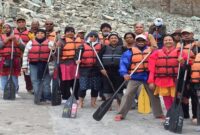Travel clubs for single seniors offer a unique and enriching experience, fostering independence and camaraderie. These clubs cater to diverse interests, from adventurous expeditions to relaxing cultural immersions, providing carefully curated itineraries and a supportive community. Whether you crave exploring ancient ruins, lounging on pristine beaches, or discovering vibrant cityscapes, a travel club can tailor an unforgettable journey designed specifically for active seniors seeking companionship and exploration.
This exploration delves into the various types of clubs available, popular destinations, crucial safety considerations, the social benefits, and practical planning advice. We’ll also address health, wellness, and budgeting concerns, empowering single seniors to embark on their dream adventures with confidence and peace of mind.
Types of Travel Clubs for Single Seniors
Finding the perfect travel companion can be challenging, especially for seniors. Travel clubs specifically designed for single seniors offer a fantastic solution, providing opportunities for socializing, exploring new places, and creating lasting memories without the need for a pre-existing travel partner. These clubs cater to diverse interests and budgets, ensuring a suitable option exists for everyone.
Categories of Travel Clubs for Single Seniors
Several distinct categories of travel clubs cater specifically to the needs and preferences of single seniors. These clubs differentiate themselves through the types of experiences offered, the level of luxury provided, and the overall travel style. Common categories include adventure travel, luxury travel, and cultural immersion trips. Each category presents a unique blend of activities, destinations, and overall experience.
Comparison of Membership Fees and Benefits
Membership fees and benefits vary significantly across different travel clubs for single seniors. Factors such as the type of travel (adventure vs. luxury), the length and frequency of trips, and the level of included services all contribute to the overall cost. Generally, luxury travel clubs command higher membership fees but offer more inclusive amenities, while adventure travel clubs might have lower fees but require a higher degree of personal investment. Cultural immersion trips can fall anywhere in between, depending on the specific destination and the level of guided experiences provided. For example, a luxury club might include airfare, five-star accommodations, and private excursions, whereas an adventure club might focus on group activities and budget-friendly lodging.
Comparison Table of Three Travel Club Types
The following table compares three distinct types of travel clubs: Adventure, Luxury, and Cultural Immersion. Note that these are examples and specific costs and offerings will vary based on the individual club and the chosen trip.
| Feature | Adventure Travel Club | Luxury Travel Club | Cultural Immersion Club |
|---|---|---|---|
| Approximate Annual Membership Fee | $200 – $500 | $1000 – $5000+ | $400 – $1500 |
| Typical Destinations | National Parks, Hiking Trails, Remote Locations (e.g., Costa Rica, Nepal) | Five-star Resorts, Exclusive Destinations (e.g., Caribbean Islands, European Capitals) | Historic Cities, Ancient Sites (e.g., Italy, Japan, Peru) |
| Activities | Hiking, Kayaking, Camping, Wildlife Viewing | Spa Treatments, Gourmet Dining, Private Tours, Fine Wine Tastings | Guided Museum Tours, Cooking Classes, Historical Site Visits, Language Lessons |
| Membership Requirements | Good physical health, willingness to participate in moderately strenuous activities | No specific physical requirements, but a preference for a sophisticated travel style | Interest in history and culture, willingness to engage in group activities and learn new things |
Social and Community Aspects of Travel Clubs
Joining a travel club specifically designed for single seniors offers significant advantages beyond the exciting travel opportunities. The inherent social aspect fosters a sense of belonging and combats the isolation that can sometimes accompany later life, leading to improved well-being and enriching experiences. These clubs provide a structured environment for meeting like-minded individuals, sharing experiences, and creating lasting friendships.
The core benefit of these clubs lies in the opportunity for meaningful social interaction and community building. For many seniors, especially those who are single, maintaining a vibrant social life can be challenging. Travel clubs offer a ready-made network of individuals who share a common interest in travel and exploration, thus overcoming geographical barriers and facilitating the formation of friendships. This combats loneliness and promotes a sense of purpose and engagement.
Social Activities and Events
Travel clubs for single seniors typically offer a range of social activities and events designed to enhance the overall travel experience and foster camaraderie among members. These extend beyond the organized trips themselves, providing opportunities for interaction both during and outside of scheduled excursions. The frequency and type of events vary depending on the specific club, but common offerings include pre-trip meetups to allow members to get acquainted, post-trip gatherings to reminisce and share photos, and social events such as dinners, games nights, and even volunteer activities. Some clubs might organize themed events, such as wine tasting or cooking classes, further enhancing the social interaction. These events often take place in convenient locations, making participation accessible to a wide range of members.
Friendship Formation and Lasting Connections
The shared experiences of travel, coupled with the structured social events, create a fertile ground for the development of strong friendships and lasting connections. The common interests and life stage of the members provide a foundation for genuine rapport and understanding. Members often bond over shared travel adventures, overcoming challenges together and creating memories that strengthen their bonds. The consistent interaction through both travel and social events allows for deeper connections to form, moving beyond superficial acquaintanceship to meaningful friendships. Many members report forming close friendships that extend far beyond the confines of the club’s activities, maintaining contact and even travelling together independently of the organized club trips. This fosters a sense of belonging and mutual support that enhances the overall quality of life for members.
Planning and Logistics of Single Senior Travel
Planning a trip with a single seniors’ travel club offers a unique blend of adventure and companionship. Careful planning, however, is crucial to ensure a smooth and enjoyable experience, maximizing the benefits of group travel while minimizing potential stress. This section details the process, from initial concept to comfortable arrival at your destination.
Trip Planning with a Travel Club
Joining a travel club simplifies many logistical aspects. The club typically handles much of the planning, negotiating group rates for flights and accommodations, and organizing excursions. However, individual preparation remains essential. The planning process generally involves several key steps:
- Choosing a Destination and Trip Type: Review the club’s upcoming itineraries, considering factors such as climate, activity level, and personal interests. Clubs often offer diverse options, from relaxing beach vacations to adventurous hiking trips. Consider your physical capabilities and preferences when making your selection.
- Booking and Payment: Once you’ve chosen a trip, adhere to the club’s registration deadlines and payment schedules. Many clubs require deposits to secure your spot and final payments weeks or months before departure.
- Pre-Trip Communication: Stay in contact with the club’s organizers. They’ll provide important updates, such as flight information, accommodation details, and pre-trip briefings. Active participation in these communications ensures you’re well-prepared for the journey.
- Travel Insurance: Secure comprehensive travel insurance that covers medical emergencies, trip cancellations, and lost luggage. This is a vital step, especially for senior travelers.
Packing for Senior Travel
Packing light is key for comfortable senior travel. Prioritize comfort and accessibility. Avoid overpacking by carefully selecting versatile clothing items.
- Clothing: Pack lightweight, wrinkle-resistant clothing in neutral colors that can be mixed and matched. Include comfortable walking shoes, and consider packing a small, lightweight travel umbrella.
- Medications: Carry all essential medications in their original containers, along with a copy of your prescriptions. Pack a sufficient supply to last the entire trip, plus a few extra days’ worth in case of delays.
- Toiletries: Use travel-sized containers for toiletries to save space and comply with airline regulations. Remember any specific skin care or personal care items you may need.
- Documents: Keep all important travel documents – passport, visa (if required), flight tickets, hotel confirmations, and travel insurance information – organized in a readily accessible place. Consider making copies and storing them separately.
- Other Essentials: Include a small first-aid kit, comfortable reading glasses, a reusable water bottle, and any other personal items that contribute to your comfort and well-being. A small, lightweight day bag for excursions is also recommended.
Sample Seven-Day Accessible Itinerary
This sample itinerary focuses on ease of travel and accessibility, ideal for a group of single senior travelers. The location is a hypothetical coastal town known for its accessibility features.
- Day 1: Arrival and check-in at an accessible hotel with elevators and ramps. Relaxation and orientation walk along a flat, paved promenade.
- Day 2: Guided tour of the town’s historical sites, using accessible transportation such as a bus with ramps or a wheelchair-accessible taxi. Lunch at a restaurant with accessible facilities.
- Day 3: Visit a local museum with wheelchair access and audio guides. Afternoon spent at a park with accessible pathways and seating.
- Day 4: Relaxing day at the beach. Accessible beach wheelchairs or other mobility aids may be available for rent. Enjoy a leisurely lunch at a beachside cafe with accessible seating.
- Day 5: Optional excursion to a nearby botanical garden with accessible pathways and signage. Alternative option: shopping in the town center, taking advantage of accessible shops and stores.
- Day 6: Free time for personal exploration or relaxation. Opportunity for individual shopping, sightseeing, or simply enjoying the hotel amenities.
- Day 7: Departure.
Budgeting and Financial Planning for Senior Travel
Planning a trip as a single senior requires careful budgeting to ensure a memorable and financially responsible experience. This involves a realistic assessment of expenses and proactive strategies for saving money and managing potential unforeseen costs. A well-structured financial plan is key to enjoying your travels without compromising your financial security.
Creating a Realistic Travel Budget
Developing a realistic travel budget necessitates a comprehensive breakdown of anticipated expenses. Begin by identifying your destination and travel dates, as these significantly influence costs. Then, meticulously list all expected expenses, including flights, accommodation, transportation within the destination, activities, meals, and incidentals like souvenirs or tips. Consider using a spreadsheet or budgeting app to track these expenses effectively. For example, if planning a 10-day trip to Europe, allocate specific amounts for airfare (e.g., $1200), accommodation (e.g., $100/night x 10 nights = $1000), daily food expenses (e.g., $50/day x 10 days = $500), activities (e.g., $200), and a contingency fund (e.g., $300). This detailed breakdown allows for a clear picture of total anticipated expenditure. Remember to factor in any visa or passport fees, travel insurance, and potential medical expenses.
Saving Money on Travel Costs
Several strategies can help single seniors save money on travel expenses. Finding affordable flights often involves booking well in advance or being flexible with travel dates. Consider using flight comparison websites to find the best deals. Similarly, accommodation costs can be minimized by choosing budget-friendly options like hostels (if comfortable), guesthouses, or Airbnb rentals instead of luxury hotels. For activities, explore free or low-cost options such as walking tours, visiting free museums on specific days, or enjoying local parks and markets. Packing light can also reduce baggage fees and potentially simplify transportation. Taking advantage of senior discounts offered by airlines, hotels, and attractions can also significantly reduce overall expenses. For instance, many museums offer free or reduced admission for seniors.
Financial Planning for Unexpected Expenses
Unforeseen circumstances can arise during travel, so it’s crucial to incorporate a contingency fund into your budget. This fund should cover potential unexpected expenses such as medical emergencies, flight cancellations, lost luggage, or unexpected repairs. A general rule of thumb is to allocate 10-20% of your total travel budget for unforeseen events. Travel insurance is another essential aspect of financial planning. A comprehensive travel insurance policy can provide coverage for medical expenses, trip cancellations, and lost belongings, offering significant peace of mind. Before purchasing, compare policies from different providers to find the best coverage at a reasonable price. Consider the level of coverage you need based on your itinerary and health status. For example, if traveling to a region with a high risk of medical emergencies, a policy with extensive medical coverage would be advisable.
Conclusion
Embarking on a journey with a travel club designed for single seniors offers a unique blend of independence, adventure, and social connection. By carefully considering the factors discussed – from choosing the right club and destination to prioritizing safety and budgeting effectively – single seniors can confidently plan and enjoy enriching travel experiences that create lasting memories and foster fulfilling friendships. The world awaits, and the journey is best shared.



